The Real Thanksgiving
Following Waldorf Education founder Rudolf Steiner’s indication that nothing should be brought into the classroom that is not meant to last for the child’s whole life, Berkshire Waldorf School teachers are conscientious and deeply thoughtful about the stories they tell, understanding that they are intended to live in our lives, our children’s lives, and in our school, well beyond our time.
Teaching with Stories
Stories are powerful. Starting in Early Childhood, teaching in Waldorf Schools is brought to the children as a story. Stories have been an effective information delivery system for human beings for millennia. They teach ideas and concepts, but also ways of being, moral situations and solutions, manners, creative problem-solving, cultural heritage, diverse points of view, identity, belonging, and much more. They touch the heart, not only the mind, appealing to each child’s imagination and curiosity. They engage us on a personal level, relevant to our own experience, and attach effectively to feelings and memory. Stories teach us how to be human.
The True Story of Thanksgiving
As we know, the true story of Thanksgiving is vastly different from the one told to us in our own Elementary School assemblies as children. The stereotypical story of pilgrims and Indians sharing a peaceful feast has had vast, devastating and lasting repercussions for Native nations. That’s why it’s so important to separate myth from history. Right here in New England, the Wampanoag Tribe first experienced the arrival of European settlers about 400 years ago in Patuxet (Plymouth).
BWS parent Lev Natan of Alliance for a Viable Future writes, “While Thanksgiving is a time of gratitude, we must acknowledge the true history of its origins and what it meant for the future of the Indigenous people of North America and their descendants.”
The Whole Story
Since 1970, the United American Indians of New England (UAINE) have marked Thanksgiving as a National Day of Mourning, a day of protest and remembrance for all that has been taken. (Learn more about it in Resources, below.)
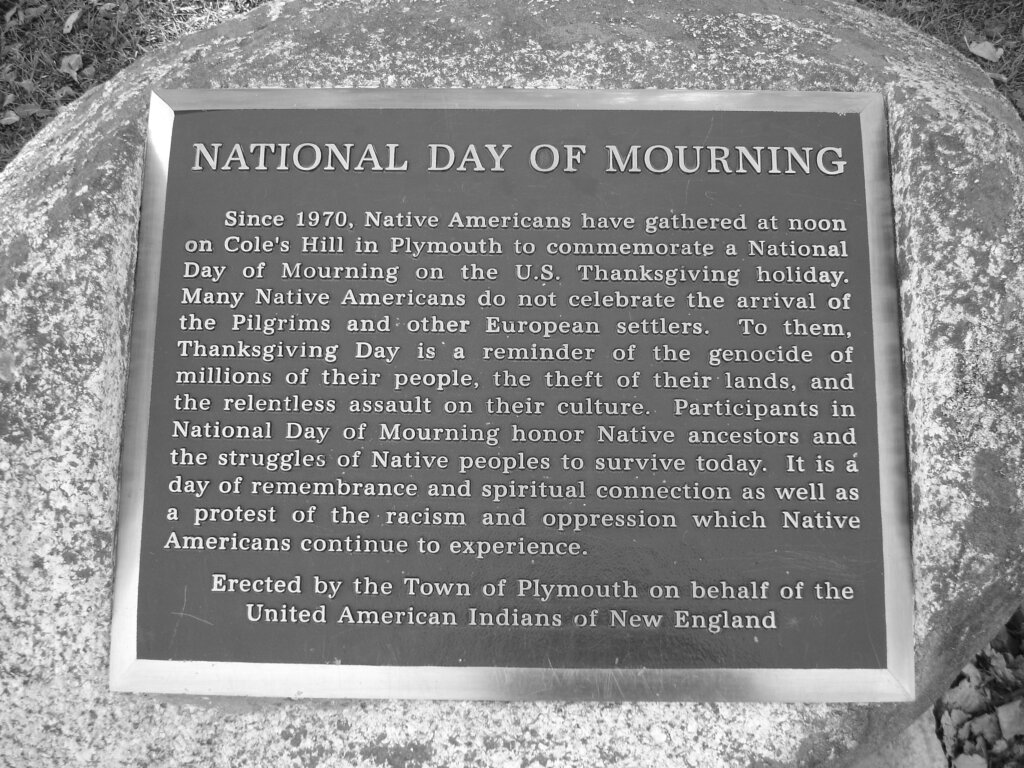
How to Tell the Thanksgiving Story to Children
As parents, educators and caregivers, we’d like to offer some resources regarding the celebration of Thanksgiving. We believe it’s important that we keep evolving the conversation about the meaning of this holiday, as we grow with our families and little ones.
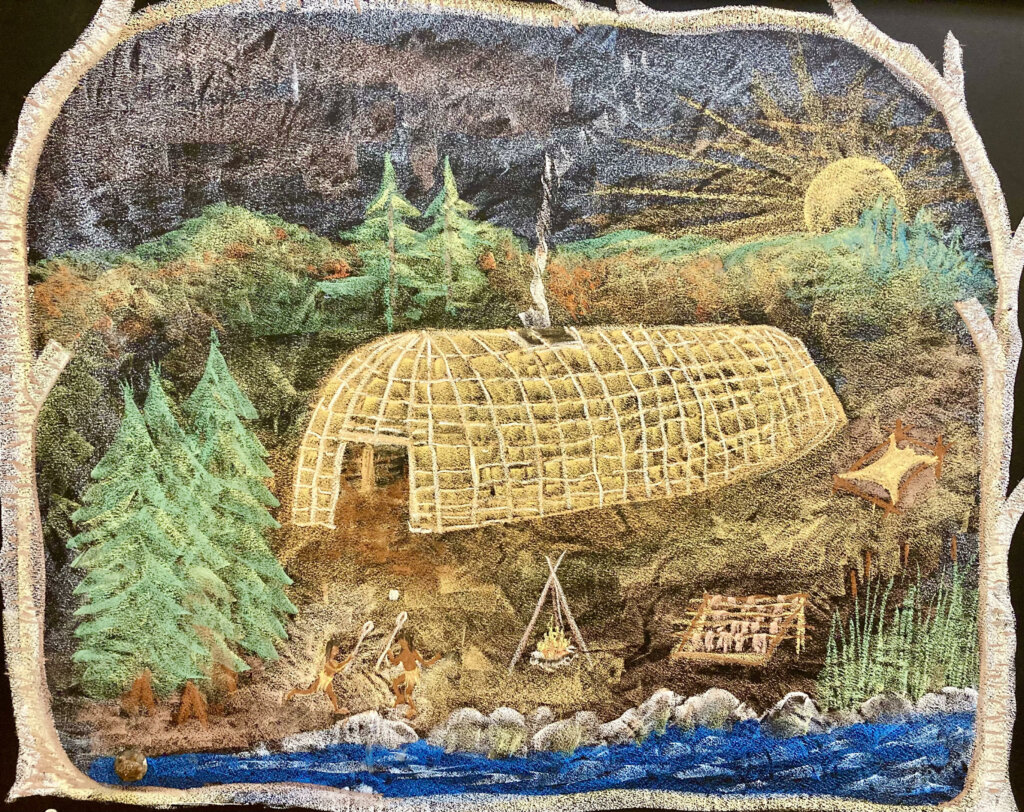
For very young children, Rose Room Nursery teacher Beth Oakley writes, “It’s enough to consciously introduce them (without tokenizing) to stories and appreciations of Indigenous people and traditions during this time of year in a meaningful way. If we as grown-ups carry this gesture of appreciation and acknowledgment with us during our Thanksgiving celebrations, the children will pick up on that inner mood, and grow to be even better human beings because of it.”
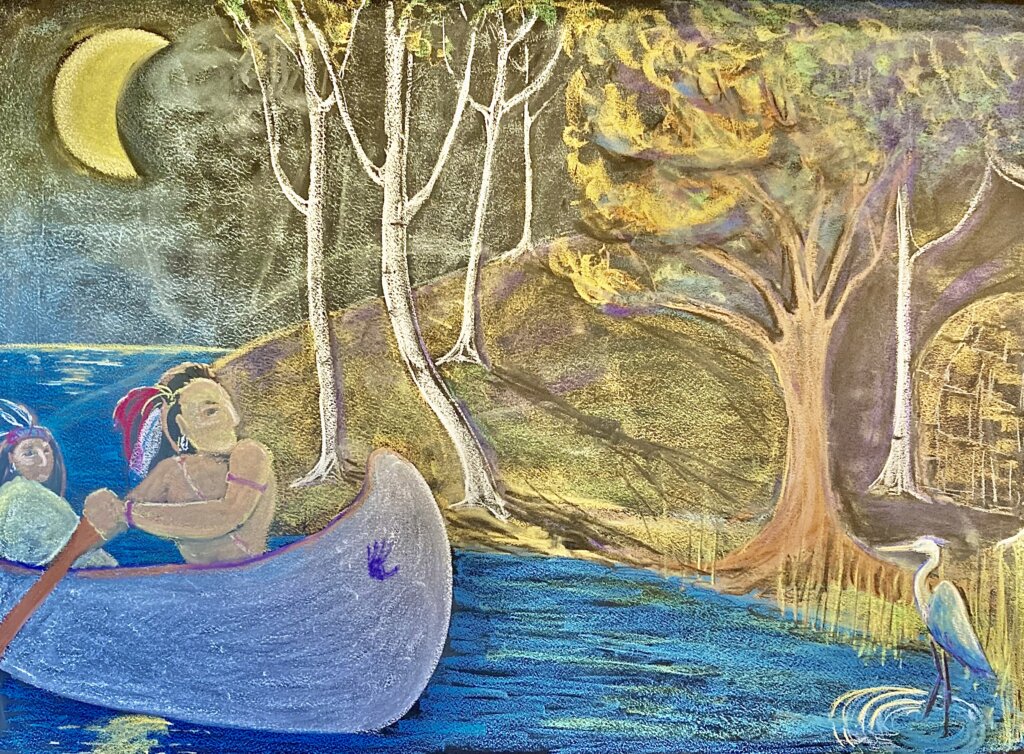
Ms. Beth adds, “Books are perhaps the best and easiest way to lovingly and gently ‘educate’ young children on concepts such as appreciation, anti-racism, inclusion and equity, and there is some stellar children’s literature out there to read to your little one at home.”
Another Point of View
This Thanksgiving, we have a special gift to share with you, a new book called Keepunumuk: Weeâchumun’s Thanksgiving Story. This is the story of the “first Thanksgiving” from the First Nations point of view, co-written by Danielle Greendeer (Wampanoag), Anthony Perry (Chickasaw – BWS Admissions Director/DEI Committee Chair Robyn Coe’s cousin), and Alexis Bunten (Unangan/Yup’ik), and illustrated by Garry Meeches, Sr. (Anishinaabe). The story, told from Weeachumun’s (Corn) point of view, includes a planting guide for growing the Three Sisters – corn, beans and squash – that traditionally sustained the Wampanoag, and that saved the pilgrims during their first year in Patuxet.
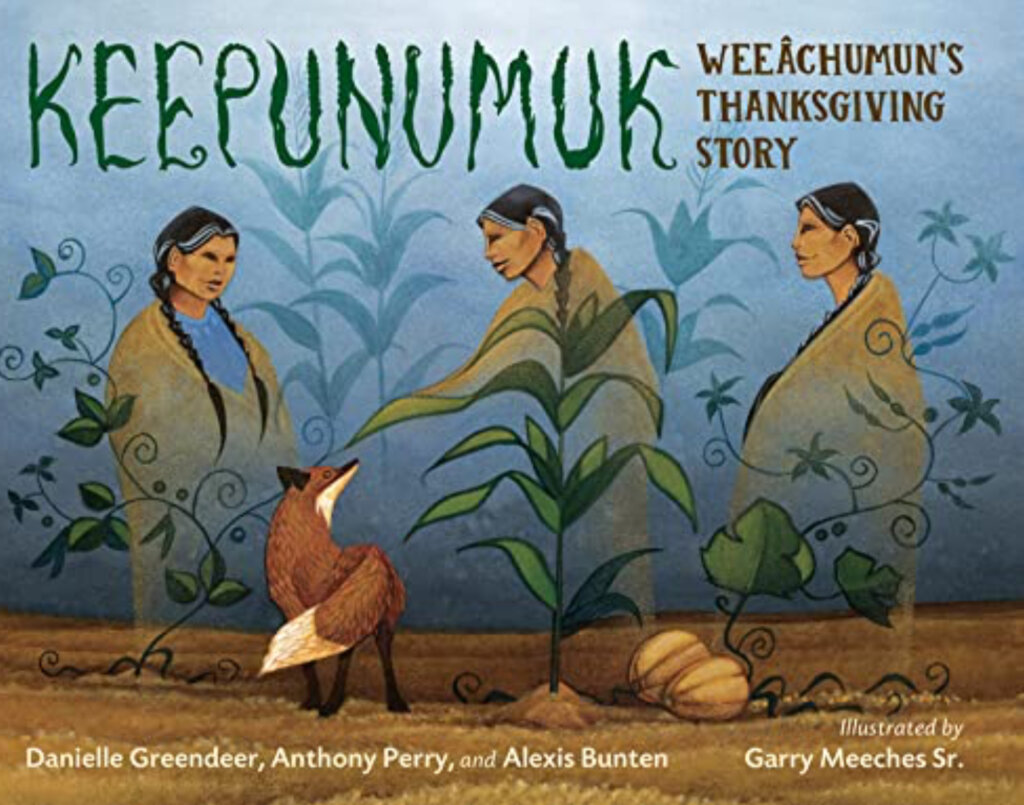
Getting Started
We recommend visiting Anishinaabe author Louise Erdrich’s Birch Bark Books, a Native-owned resource for literature that has twenty-nine full pages of children’s books available. And of course, these books should not only be visited this time of year, but all year. Consider learning and sharing the true story of Thanksgiving as a jumping off point for so much more learning.
Wishing you and your family the warmth of belonging, remembering that everyone deserves a seat at the table and welcome for the gifts they bring.
More Resources for Adults
Rose Room Nursery teacher Beth Oakley recommends reading this article from The Atlantic about the Wampanoag, and heading over to Teaching Tolerance for more resources.
We encourage you to visit the Mashpee Wampanoag Tribe‘s website. In addition, you can learn more about the UAINE’s National Day of Mourning (which takes place on Cape Cod every Thanksgiving at noon, including via live feed – quite a difference from the Macy’s Thanksgiving Day parade) and how to talk to children about Thanksgiving right here on our blog.
Berkshire Multiracial Families shared this interview, in which Cherokee children’s book author Traci Sorell (We Are Grateful: Otsaliheliga) discusses how to talk about Thanksgiving with kids.
Kieran Riley, husband of Pedagogical Lead Christianna Riley and “Farmer Kieran” to the children, shares this video reporting from his radio show on WGXC Hudson about the Wampanoag National Day of Mourning :
- Why These Native Americans Observe a National Day of Mourning (Huffington Post)
- The Harsh Truth About Thanksgiving – an interview with Larissa FastHorse, author of ‘The Thanksgiving Play’ (NowThisNews)
- Why the Story of Thanksgiving is a Lie (Smoke Signals)
- Native American Girls Describe the Real History Behind Thanksgiving (Teen Vogue)
- Unthanksgiving Day, a National Day of Mourning (Twinkl/USA)
From Keepunumuk co-author Alexis Bunten at Bioneers:
Here’s how we honored First Nations weekend in Great Barrington/Mohican Nation in October 2022. You’ll see many of our students and community members joining this public ceremony. On the Tuesday following First Nations Day, Mohican ambassador Shawn Stevens visited BWS to teach in the full Grades School circle.
- Northeast Indigenous Council on Climate Change – Watch this one first, it’s amazing! – Click Here
- Indigenous Peoples’ Day Ceremonial Walk – Click Here
- Video made by Southern Berkshires Community Television – Click here
Thanks for Sharing
YKK CPL! That’s Chickasaw shorthand for yakoke (thanks), che pisa la cho (see you next time).
–Admissions Director Robyn Perry Coe (Chickasaw Nation)
Giving Thanks
Now our minds are one.
For the first time in many months, our community gathered this week to give thanks, for the earth and the Muhhekunneuw (Muh-he-con-ok) elders and land keepers who have lived in balance and unity for 10,000 years on the sacred land on which we learn together.
Now called the Stockbridge-Munsee Band of the Mohican Nation, the first nations people of our region are alive and well in Wisconsin, and are returning to their homeland. We strive to live in relationship, respect and shared values with their community. To do that, we open our hearts and turn our minds toward listening.
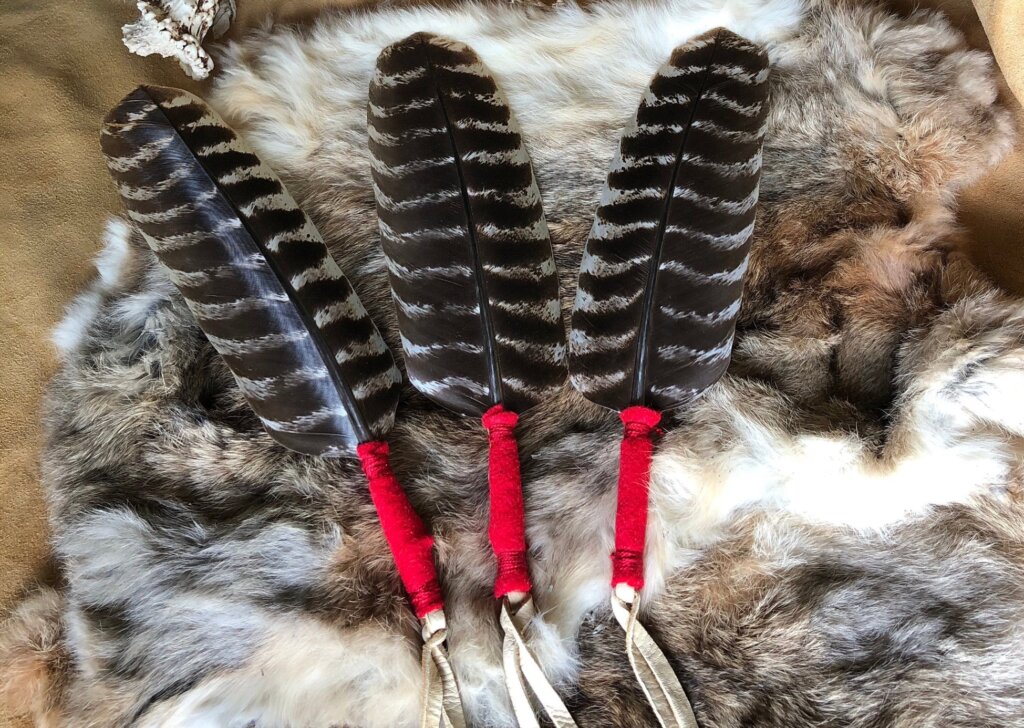
Living Stories
At the assembly, each of the grades classes shared a little of what they have been learning during Fall term. Waldorf teachers bring all they teach to the children through story. When BWS adapted Waldorf education for COVID times, much of our learning went outside. Starting in November, when temperatures dip below freezing, we light a fire every morning for outside classes. Hearing stories around the fire is ancient learning technology, both essentially human and unforgettable.
Second grade has been learning stories from the Muh-he-con-ne-ok (Mohican, now known as the Stockbridge-Munsee community) and the Haudenosaunee (Iroquois Confederacy). Our teachers feel strongly that Berkshire Waldorf students should learn the stories native to this land, before extending out to stories of cultures across the world, putting these stories at the center of the here and now.
Haudenosaunee Thanksgiving Address
Third grade has also been learning from the Haudenosaunee. At the assembly, they recited a portion of the Haudenosaunee Thanksgiving Address.
Today we have gathered and we see that the cycles of life continue. We have been given the duty and responsibility to live in balance and harmony with each other and all living things. So now, we bring our minds together as one, as we give our greetings and our thanks to one another as people.
It’s important to know that the Haudenosaunee thanksgiving is not a once-a-year event. Just as the Haudenosaunee do, Waldorf students and teachers begin their days with a blessing, preparing to work together and do their best, and building collective strength in this way.
Many of the grades hung turkey feathers in the apple trees in the big backyard – each feather a blessing of gratitude. These are ways to begin to reclaim the meaning of Thanksgiving. Seventh grade smudged with sage around their fire, to purify seeing, hearing, speaking, hearts and minds. These actions are the beginning of reframing Thanksgiving in our diverse community.
We are Grateful
So you might be wondering, What do I tell my children about Thanksgiving?
To reiterate from our blog post last year, start with learning together about Thanksgiving and ways to practice gratitude from Indian writers and storytellers. Learn about food sovereignty, and consider adding diversity to your celebration with a dish that includes rich indigenous flavors like corn, beans and squash. More learning resources are listed below.
As adults, learn that not everyone is feasting and celebrating; indigenous people, especially in New England – especially in Massachusetts – are fasting, and meeting at Plymouth Rock to hold this day as a National Day of Mourning.
While it’s important that parents know and acknowledge the truth of history, fourth grade teacher Victoria Cartier points out that you will want to tune what you say to your child’s age and development.
For example, with early childhood students, the focus is on making food and saying a blessing for all the good gifts of the earth.
“And I would add, give gratitude to nature,” Pumpkin Patch Kindergarten teacher and Pedagogical Lead Christianna Riley suggests. “Take walks in nature, be in wonder together and admire its beauty. Young children are so good at finding ordinary rocks or sticks as beautiful and special treasures. We can learn from them.”
With third graders, Ms. Cartier says she would emphasize generosity, working together for the good of all, and gratitude. In eighth grade, children are ready for and seek the truth, and that’s a time to share more details. In high school, students will want to act for justice.
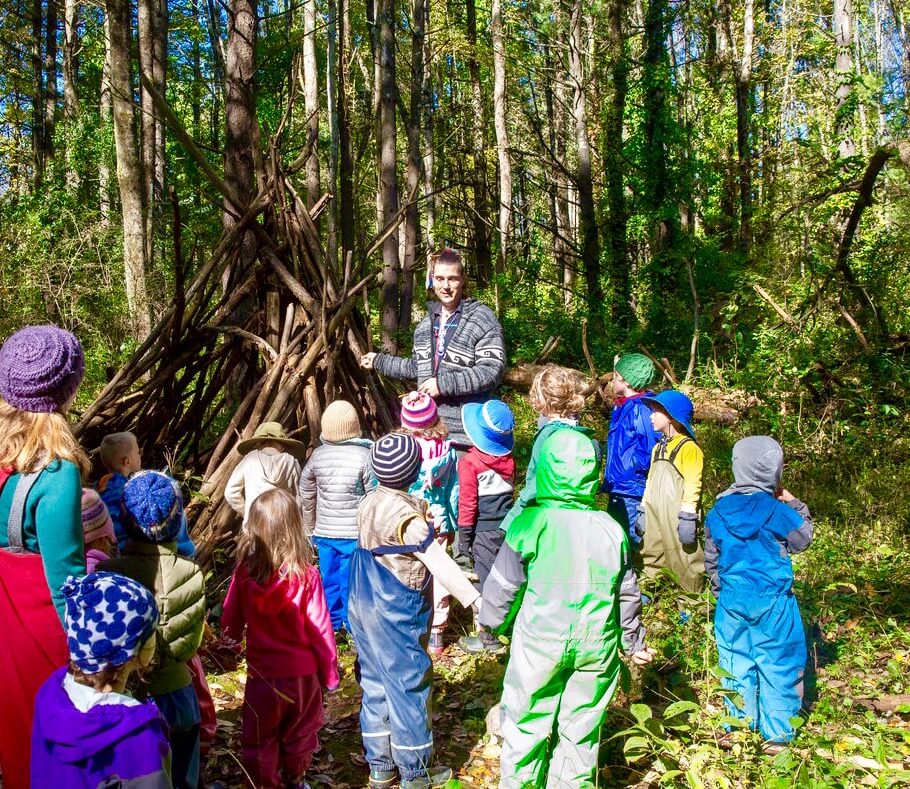
More Resources:
Haudenosaunee Thanksgiving Address:
americanyawp.com/reader/british-north-america/haudenosaunee-thanksgiving-address
Learn more about the true story of Thanksgiving:
https://berkshirewaldorfschool.org/rethinking-thanksgiving/
Visit Berkshire Museum (through 1/9/22) to learn more about the past, present and future of the Mohican Nation:
http://berkshiremuseum.org/portfolio-item/muh-he-con-ne-ok
What you can do now to promote healing:
What do we celebrate when we celebrate Thanksgiving?
We are all so ready for some celebration. We have almost made it through the fall term, miss our friends and family, and long for a sense of normalcy, to help orient ourselves in this disorienting time.
How do we celebrate, when not everyone is celebrating? This year, we are truly thankful for another journey around the sun. To celebrate in the midst of so much loss, when the earth is calling for a time of introspection and healing, means holding our families close. From closeness comes comfort and calm.
Our community’s outpouring of generosity in this time of need, by actions such as giving food to the Peoples’ Pantry, is a start at widening the circle of love and support to our neighbors. Part of what we celebrate with sharing is that the Indians in what is now Plymouth, MA gave “essential survival knowledge to the Pilgrims and taught them how to cultivate the land, including teaching them which crops grew well, how to avoid dangerous and poisonous plants, and how to extract sap from maple trees.”
Do we see the mercy and the generosity of people who did not see the “other” as an enemy, but as a human being? Do you know what became of Ousamequin, know as Massasoit or great sachem (leader), and Tisquantum (Squanto), and how this generosity was repaid?
The “First Thanksgiving”
In a speech planned for the 350th anniversary of the Pilgrims’ landing at Plymouth rock in 1970, Wampanoag Wamsutta James wrote these remarks:
It is with mixed emotion that I stand here to share my thoughts. This is a time of celebration for you—celebrating an anniversary of a beginning for the white man in America. A time of looking back, of reflection. It is with a heavy heart that I look back upon what happened to my People.
Even before the Pilgrims landed it was common practice for explorers to capture Indians, take them to Europe and sell them as slaves for 220 shillings apiece. The Pilgrims had hardly explored the shores of Cape Cod for four days before they had robbed the graves of my ancestors and stolen their corn and beans. Mourt’s Relation describes a searching party of sixteen men. Mourt goes on to say that this party took as much of the Indians’ winter provisions as they were able to carry.
Massasoit, the great Sachem of the Wampanoag, knew these facts, yet he and his People welcomed and befriended the settlers of the Plymouth Plantation. Perhaps he did this because his Tribe had been depleted by an epidemic. Or his knowledge of the harsh oncoming winter was the reason for his peaceful acceptance of these acts. This action by Massasoit was perhaps our biggest mistake. We, the Wampanoag, welcomed you, the white man, with open arms, little knowing that it was the beginning of the end; that before 50 years were to pass, the Wampanoag would no longer be a free people.
National Day of Mourning
Instead, James was not allowed to speak these words. Since the year his speech was suppressed, this day has marked a National Day of Mourning. Moonanum James and Mahtowin Munro explain:
Every year since 1970, United American Indians of New England have organized the National Day of Mourning observance in Plymouth at noon on Thanksgiving Day. Every year, hundreds of Native people and our supporters from all four directions join us. Every year, including this year, Native people from throughout the Americas will speak the truth about our history and about current issues and struggles we are involved in.
Why do hundreds of people stand out in the cold rather than sit home eating turkey and watching football? Do we have something against a harvest festival?
Of course not. But Thanksgiving in this country—and in particular in Plymouth—is much more than a harvest home festival. It is a celebration of the Pilgrim mythology.
According to this mythology, the pilgrims arrived, the Native people fed them and welcomed them, the Indians promptly faded into the background, and everyone lived happily ever after.
The truth is a sharp contrast to that mythology.
Telling the Story is Teaching the Story
In eighth grade American history, our students learn about Revolution—the French Revolution, American Revolution, French and Indian Wars, the so-called Beaver Wars, and the Industrial Revolution. To the victor go the spoils. The victors also control the story, which includes the stories in children’s books and textbooks.
So consider the story of the “First Thanksgiving” as just that, a story—the New York times recently called it a myth. American Indian Movement activist Russell Means called Thanksgiving “Thankstaking.” He also points out that there were many feasts in Plymouth when the Indians shared food with their starving neighbors, but that the first “official” Thanksgiving Governor William Bradford declared was in gratitude for the massacre of an Indian village. Even Parenting Magazine writes, “Thanksgiving signifies a whitewashing of history, and an attempt to deflect from the atrocious harm caused to indigenous groups by European settlers.”
True History of U.S. (Us)
On First Nations Day this year, Pumpkin Patch kindergarten teacher and member of the BWS Diversity, Equity and Inclusivity (DEI) Committee Christianna Riley visited the New England Peace Pagoda. She writes:
I had the great privilege of being invited to the New England Peace Pagoda’s 35th Inauguration Ceremony (socially distanced and responsible). I am including the link to a livestream that was taken. This is for parents only. The part I would like to share with you begins around 48 minutes into the livestream, a beautiful song and then a speech given by Sonia Little of the Mashpee Wampanoag Nation, located in what we now call Cape Cod, Mass. Sonia is the granddaughter of the late Supreme Medicine Man of the Wampanoag People, Slow Turtle. She gives a heartbreaking, clear and concise truth about the history of the USA and the First Nations of Turtle Island. I believe that hearing Sonia speak is a deed of great courage. This is the history of the USA and of Humanity. We are all related and connected. This is an offering to raise our awareness and to know history so that we can make a better future for our children and the Earth.
We are Grateful
So you might be wondering, What do I tell my children about Thanksgiving?
Start with learning about Thanksgiving and ways to practice gratitude from Indian writers and storytellers. Learn about food sovereignty, and consider adding diversity to your celebration with a dish that includes rich indigenous flavors like corn, beans and squash. Some resources are listed below.
While it’s important that parents know and listen to the truth of history, third grade teacher Victoria Cartier points out that you will want to tune what you say to your children’s age and development. For example, with early childhood students, the focus is on making the food and saying a blessing for all the good gifts of the earth. “And I would add gratitude to nature,” Mrs. Riley suggests. “Taking walks in nature, being in wonder and admiring its beauty. Young children are so good at finding ordinary rocks or sticks as beautiful and special treasures. We can learn from them.” With third graders, Ms. Cartier says she would emphasize generosity, working together for the good of all, and gratitude. In eighth grade, children are ready for and seek the truth, and that’s a time to share more details. In high school, students will want to act for justice.
Making Space for Listening
Some believe that the world will not heal until the earth can heal, and that in order to restore health, nations who have been “removed” must return to their sacred homelands. The water protectors, as you know, stood at Standing Rock for all of us—people and animals alike. The Lenape, who traded Manhattan for trinkets because they couldn’t conceive of selling the earth, are beginning to return to New York, working to teach what they know to save the earth for all. Once again, we are hungry in so many ways, and winter is approaching. Can we listen, and return generosity and mercy with respect and dignity? Can we change the end of the story this time, so all life can flourish? Let our celebration be a commitment to hearing all voices, leaving a space for silence so we can hear what the world is asking of us.
Some Resources:
We Are Grateful: Otsaliheliga by Traci Sorell
Squanto’s Journey: The Story of the First Thanksgiving by Joseph Bruchac
1621: A New Look at Thanksgiving by Catherine O’Neill Grace
The Thanksgiving Myth Gets a Deeper Look This Year
How to Celebrate Native Americans This Thanksgiving
Listen to Indigenous American Podcasts
Cook 10 Essential Indigenous Foods with The Sioux Chef
Faces of the Lenape Tribe, the Original Inhabitants of Manhattan
Massasoit’s Strategic Diplomacy Kept Peace With the Pilgrims for Decades







